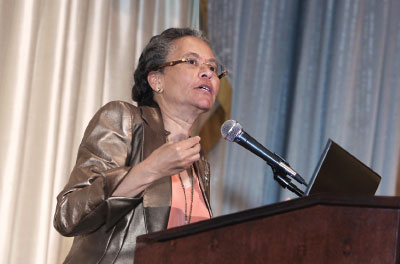Public Health Physician Offers Vivid Parables of Social Inequity
Abstract
Addressing the racially determined structures that influence the social determinants of health is vital for large and sustained improvements in public health.
Camara Jones, M.D., Ph.D., M.P.H., knows how to tell a story. And her stories have a remarkable capacity to make possible, through powerful visual metaphors, conversations and new ways of thinking about difficult topics: racism, the social determinants of health, and the social determinants of inequity.

“Racism is a system of structuring opportunity and assigning value to people based on what we call race—the social interpretation of how one looks,” Camara Jones, M.D., Ph.D., M.P.H., tells IPS attendees.
Several of these stories, which Jones has shared with audiences over the years, have proliferated on the internet: look up on YouTube “the Cliff analogy,” “allegories on race and racism,” or “the gardener’s tale.”
APA members attending last month’s IPS: The Mental Health Services Conference in Chicago got to hear those stories firsthand when Jones delivered the keynote address at the Opening Session. She is a past president of the American Public Health Association (2015-2016) and a senior fellow at the Satcher Health Leadership Institute and the Cardiovascular Research Institute at the Morehouse School of Medicine.
As a parable of how the reality occupied by people of color is typically invisible through the lens of white privilege, Jones offered an analogy from her days as a medical student. She and her friends had been up late studying when they decided to go to a nearby diner for a late-night meal. They were seated at a table and served, but later she happened to notice the sign on the door. From where she sat, she could see a sign that read “Open,” yet passersby outside would stop at the door as if they wanted to enter but then would move on.
Clearly, the diner had closed to more customers since she and her companions had been seated, and what looked to her like a sign saying “Open” was a sign saying “Closed” to those outside. “Racism structures a dual reality,” she remarked. “Those inside the restaurant sitting at the table of opportunity don’t even know that there is a two-sided sign.”
In a similar way, she said, the word “privilege” isn’t synonymous with “racist”; it simply concedes that the structure of society has created an uneven playing field. “Racism is a system, not a psychiatric illness and not a sign of moral failure,” Jones told attendees. “It’s a system of structuring opportunity and assigning value to people based on what we call race—the social interpretation of how one looks. It saps at the strength of the whole society through the waste of human resources.”
That system of structuring opportunity and assigning value also differentially distributes health-related resources and risks for disease and early death—the social determinants of health. To illustrate, Jones offered the “Cliff Analogy” illustrating three dimensions of health intervention to help people who are falling off of the cliff of good health: providing health services, addressing the social determinants of health, and addressing the social determinants of equity.
In the terms of the analogy, health services include an ambulance at the bottom of the cliff, a net or trampoline halfway down, and a fence at the top of the cliff. Addressing the social determinants of health involves the deliberate movement of the population away from the edge of the cliff. Addressing the social determinants of equity involves interventions on the structures, policies, practices, norms, and values that differentially distribute resources and risks along the cliff face.
Jones’s most potent allegorical story is the “gardener’s tale,” a prosaic rendering of how structural inequity determines who flourishes in society and who doesn’t and the effects on people’s perceptions down through generations.
Imagine a gardener who has two flower boxes, one that she knows to be filled with rich, fertile soil and another that she knows to be filled with poor, rocky soil. This gardener has two packets of seeds for the same type of flower. However, the plants grown from one packet will bear pink blossoms, while the plants grown from the other packet will bear red blossoms.
The gardener prefers red over pink, so she plants the red seeds in the rich, fertile soil and the pink seeds in the poor rocky soil. Sure enough, all of the red flowers grow up and flourish, with the fittest growing tall and strong and even the weakest making it to a middling height. But in the box with the poor, rocky soil, the outcome is different. The weak among the pink seeds don’t survive, and the strongest among them grow only to a middling height.
Year after year, the same thing happens. Ten years later the gardener comes to survey her garden. Gazing at the two boxes, she says, “I was right to prefer red over pink! Look how vibrant and beautiful the red flowers look, and see how pitiful and scrawny the pink ones are.” Moreover, her children and grandchildren, oblivious to the history of the two flower boxes, learn to assume which flowers are superior to the others.
Jones said the allegory highlights how addressing the racially determined structures that influence the social determinants of health is vital “if we want to have large and sustained improvements in public health.”
Jones received her medical degree from the Stanford University School of Medicine and both her M.P.H. and her Ph.D. in epidemiology from the Johns Hopkins School of Hygiene and Public Health. She completed residency training in general preventive medicine at Johns Hopkins and in family practice in the social medicine program at Montefiore Medical Center. ■
A video of Camara Jones, M.D., Ph.D., M.P.H., discussing allegories of race and racism can be accessed here.



